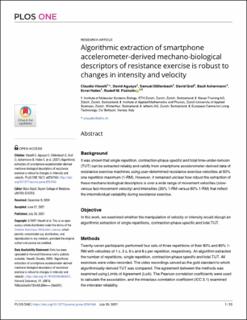Please use this identifier to cite or link to this item:
https://doi.org/10.21256/zhaw-25896| Publication type: | Article in scientific journal |
| Type of review: | Peer review (publication) |
| Title: | Algorithmic extraction of smartphone accelerometer-derived mechano-biological descriptors of resistance exercise is robust to changes in intensity and velocity |
| Authors: | Viecelli, Claudio Aguayo, David Dällenbach, Samuel Graf, David Achermann, Basil Hafen, Ernst Füchslin, Rudolf M. |
| et. al: | No |
| DOI: | 10.1371/journal.pone.0254164 10.21256/zhaw-25896 |
| Published in: | PLOS ONE |
| Volume(Issue): | 16 |
| Issue: | 7 |
| Page(s): | e0254164 |
| Issue Date: | 2021 |
| Publisher / Ed. Institution: | Public Library of Science |
| ISSN: | 1932-6203 |
| Language: | English |
| Subjects: | Accelerometer; Video recording; Acceleration; Cell phone; Body weight; Algorithm; Exercise; Velocity |
| Subject (DDC): | 005: Computer programming, programs and data |
| Abstract: | Background: It was shown that single repetition, contraction-phase specific and total time-under-tension (TUT) can be extracted reliably and validly from smartphone accelerometer-derived data of resistance exercise machines using user-determined resistance exercise velocities at 60% one repetition maximum (1-RM). However, it remained unclear how robust the extraction of these mechano-biological descriptors is over a wide range of movement velocities (slow- versus fast-movement velocity) and intensities (30% 1-RM versus 80% 1-RM) that reflect the interindividual variability during resistance exercise. Objective: In this work, we examined whether the manipulation of velocity or intensity would disrupt an algorithmic extraction of single repetitions, contraction-phase specific and total TUT. Methods: Twenty-seven participants performed four sets of three repetitions of their 30% and 80% 1-RM with velocities of 1 s, 2 s, 6 s and 8 s per repetition, respectively. An algorithm extracted the number of repetitions, single repetition, contraction-phase specific and total TUT. All exercises were video-recorded. The video recordings served as the gold standard to which algorithmically-derived TUT was compared. The agreement between the methods was examined using Limits of Agreement (LoA). The Pearson correlation coefficients were used to calculate the association, and the intraclass correlation coefficient (ICC 2.1) examined the interrater reliability. Results: The calculated error rate for the algorithmic detection of the number of single repetitions derived from two smartphones accelerometers was 1.9%. The comparison between algorithmically-derived, contraction-phase specific TUT against video, revealed a high degree of correlation (r > 0.94) for both exercise machines. The agreement between the two methods was high on both exercise machines, intensities and velocities and was as follows: LoA ranged from -0.21 to 0.22 seconds for single repetition TUT (2.57% of mean TUT), from -0.24 to 0.22 seconds for concentric contraction TUT (6.25% of mean TUT), from -0.22 to 0.24 seconds for eccentric contraction TUT (5.52% of mean TUT) and from -1.97 to 1.00 seconds for total TUT (5.13% of mean TUT). Interrater reliability for single repetition, contraction-phase specific TUT was high (ICC > 0.99). Conclusion: Neither intensity nor velocity disrupts the proposed algorithmic data extraction approach. Therefore, smartphone accelerometers can be used to extract scientific mechano-biological descriptors of dynamic resistance exercise with intensities ranging from 30% to 80% of the 1-RM with velocities ranging from 1 s to 8 s per repetition, respectively, thus making this simple method a reliable tool for resistance exercise mechano-biological descriptors extraction. |
| URI: | https://digitalcollection.zhaw.ch/handle/11475/25896 |
| Fulltext version: | Published version |
| License (according to publishing contract): | CC BY 4.0: Attribution 4.0 International |
| Departement: | School of Engineering |
| Organisational Unit: | Institute of Applied Mathematics and Physics (IAMP) |
| Appears in collections: | Publikationen School of Engineering |
Files in This Item:
| File | Description | Size | Format | |
|---|---|---|---|---|
| 2021_Viecelli-etal_Algortihmic-extraction-smartphone-accelerometer-derived-descriptors_PONE.pdf | 3.74 MB | Adobe PDF |  View/Open |
Show full item record
Viecelli, C., Aguayo, D., Dällenbach, S., Graf, D., Achermann, B., Hafen, E., & Füchslin, R. M. (2021). Algorithmic extraction of smartphone accelerometer-derived mechano-biological descriptors of resistance exercise is robust to changes in intensity and velocity. Plos One , 16(7), e0254164. https://doi.org/10.1371/journal.pone.0254164
Viecelli, C. et al. (2021) ‘Algorithmic extraction of smartphone accelerometer-derived mechano-biological descriptors of resistance exercise is robust to changes in intensity and velocity’, PLOS ONE , 16(7), p. e0254164. Available at: https://doi.org/10.1371/journal.pone.0254164.
C. Viecelli et al., “Algorithmic extraction of smartphone accelerometer-derived mechano-biological descriptors of resistance exercise is robust to changes in intensity and velocity,” PLOS ONE , vol. 16, no. 7, p. e0254164, 2021, doi: 10.1371/journal.pone.0254164.
VIECELLI, Claudio, David AGUAYO, Samuel DÄLLENBACH, David GRAF, Basil ACHERMANN, Ernst HAFEN und Rudolf M. FÜCHSLIN, 2021. Algorithmic extraction of smartphone accelerometer-derived mechano-biological descriptors of resistance exercise is robust to changes in intensity and velocity. PLOS ONE . 2021. Bd. 16, Nr. 7, S. e0254164. DOI 10.1371/journal.pone.0254164
Viecelli, Claudio, David Aguayo, Samuel Dällenbach, David Graf, Basil Achermann, Ernst Hafen, and Rudolf M. Füchslin. 2021. “Algorithmic Extraction of Smartphone Accelerometer-Derived Mechano-Biological Descriptors of Resistance Exercise Is Robust to Changes in Intensity and Velocity.” Plos One 16 (7): e0254164. https://doi.org/10.1371/journal.pone.0254164.
Viecelli, Claudio, et al. “Algorithmic Extraction of Smartphone Accelerometer-Derived Mechano-Biological Descriptors of Resistance Exercise Is Robust to Changes in Intensity and Velocity.” Plos One , vol. 16, no. 7, 2021, p. e0254164, https://doi.org/10.1371/journal.pone.0254164.
Items in DSpace are protected by copyright, with all rights reserved, unless otherwise indicated.